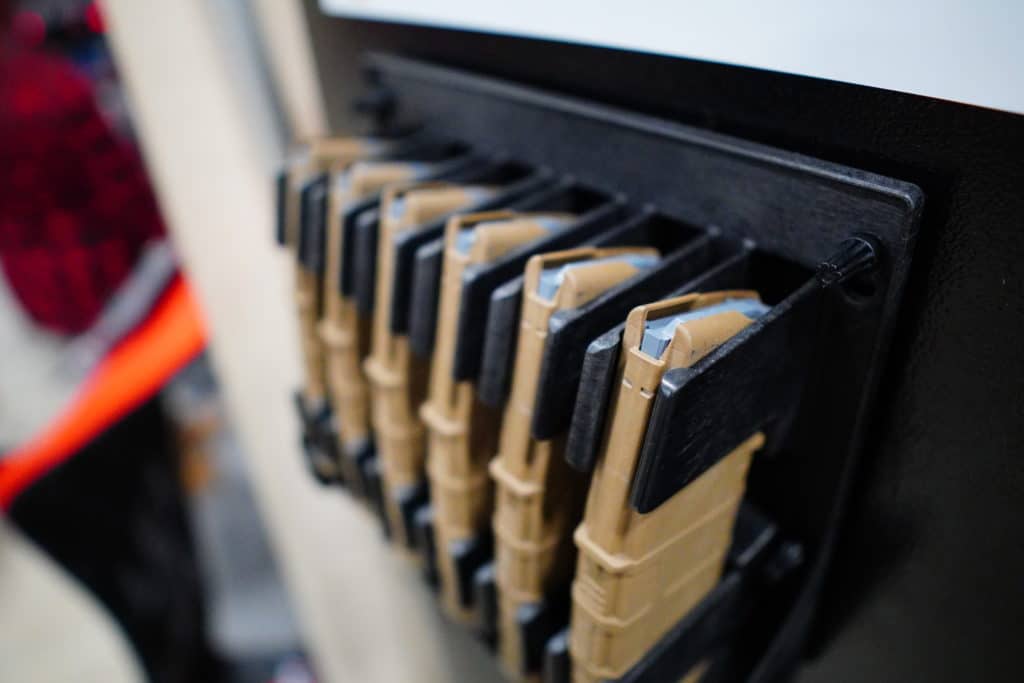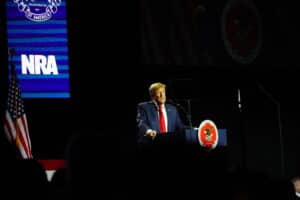This is our last newsletter before Americans head to the polls and decide what the federal government will look like for at least the next two years.
So, what will gun policy look like under either of the prospective presidencies? That’s what I try to answer both in an analysis piece and on the podcast. To help give a broader view of what may come, I have a guest this week who comes from a completely different point of view.
The Trace’s Jennifer Mascia joins the podcast to go over what a Trump or Harris Administration’s gun policy might look like in practice.
Then, I take a look at an odd new Second Amendment ruling out of the DC Circuit. I explain how the court upheld the city’s magazine ban even after finding they are “arms” in “common use” and the weaknesses in that argument.

Analysis: Realistic Expectations for Gun Policy Under Trump or Harris [Member Exclusive]
By Stephen Gutowski
Election day is nearly here.
Vice President Kamala Harris and Former President Donald Trump are locked in a close presidential race. One of them will most certainly win. Here’s a look at what to expect in either direction.
First, it’s key to set expectations for what the makeup of the federal government is likely to be. Not certainly, but likely.
Only a third of the Senate is up for election each year. Our politics are severely polarized, which limits how often candidates from the party that didn’t win a state’s presidential race are able to win its Senate race. So, the map of Senate seats up for election tells us a lot about the likely outcome.
This year, Republicans have a big advantage. The Senate is starting at a 50-50 split, and there are far more Democratic seats up for grabs in red or purple states than vice versa. It would take an abysmal performance for Republicans not to control the Senate after Tuesday.
Then there’s the House of Representatives. That, too, is currently at a nearly even split. It’s likely the winning presidential candidate will boost enough House candidates in their party to grab control of the House.
That doesn’t necessarily matter a whole lot when it comes to gun legislation, though. While a Trump win probably means full Republican control of the federal government, but only by slim margins. Those slim margins would probably prevent them from being able to pass substantial pro-gun legislation, such as national gun-carry permit reciprocity or silencer deregulation.
However, even slim majorities would give the GOP the ability to shape the spending and priorities of federal agencies like the ATF using budgeting measures that are already exempt from the filibuster.
On the flip side, a Harris presidency would probably have to contend with a Republican Senate majority. That almost certainly means none of the policy proposals she’s running on will come to fruition, at least until after the next election. Her policy platform of universal background checks, a “red flag” law, and an “assault weapons” ban won’t make it to a vote in a Republican-controlled Senate under anything like normal circumstances.
Even if Democrats maintained control of the Senate under a Harris Administration, they too would probably have a tough time finding 60 votes to pass any of their most substantial gun restrictions. The wild card in these calculations is, of course, whether one side nukes the legislative filibuster and knocks the vote threshold down to 50. Harris and Trump have both supported nuking the filibuster at various points, but each party’s Senate caucus has opposed the idea to this point. But it’s not impossible single-party control of DC could lead to the end of the filibuster, which would upend all of these predictions.
Still, the best bet for action on guns is likely to come from what the President has direct power over.
Appointing judges will be one of the longest-lasting ways Harris or Trump can have a direct impact. That’s another area where Trump would have more leeway if the Senate goes the way people expect. Judge appointments are also the area he had the strongest pro-gun accomplishments in his first term, appointing three of the Supreme Court Justices in the majority for the landmark New York State Rifle and Pistol Association v. Bruen decision.
Harris would likely continue a similar trajectory with judicial appointments as Biden, whose only Supreme Court appointee has been severely critical of the Court’s Second Amendment jurisprudence. However, she may be forced to moderate her judicial picks in order to get them through a Republican-controlled Senate. She may even face total resistance to more important appointments, as has become increasingly common in recent years.
The one area Trump or Harris wouldn’t have to worry about Congressional approval is executive action.
Trump has said he’ll fire the permanent ATF Director Biden appointed. Although, he hasn’t said who he’d replace him with and his previous nominee was rejected by his own party during his first term. He’s also promised to undo all of the rules Biden has imposed through the ATF, including the pistol brace and “ghost gun” bans. He hasn’t promised much in the way of his own rulemaking, though, and his only effort on that front during his first term was the bump stock ban his own Supreme Court appointees found unconstitutional earlier this year.
Harris would keep Biden’s ATF rules in place, though the courts may strike them down. She’ll likely try to expand on them in some way as well. But she hasn’t laid out any proposals yet, and Biden has already gone into the most obvious grey areas in federal gun law.
So, barring a radical change to either our government or our gun politics, Trump and Harris will face high hurdles to pass significant legislative reforms. But that doesn’t mean they couldn’t have a significant impact on American gun policy. Although, the likely makeup of the Senate and recent federal rulemaking gives Trump an upper hand in the potential for exercising executive power.
Podcast: What Could Trump or Harris Actually Do on Guns? (Ft. The Trace’s Jennifer Mascia) [Member Early Access]
By Stephen Gutowski
The election is just days away. In fact, it’s the day after this episode is released to the public.
The time to cover the daily developments on the campaign trail is over. Now, it’s time to look ahead at what the realistic expectations on gun policy should be for a potential Trump or Harris administration. To do that, I’ve brought somebody from an outlet on nearly the opposite side of the spectrum from The Reload.
Jennifer Mascia has been a reporter at The Trace, a non-profit publication with ties to Everytown for Gun Safety, since it was founded. She is well-sourced inside the gun-control movement and closely follows gun politics news. She joins the show to help suss out the most likely policies Trump or Harris would pursue and by what means.
Mascia and I agreed legislation is the least likely area for change since Republicans are likely to gain a Senate majority regardless of who wins the presidency–but only a narrow majority. Instead, the real action will be in court appointments and executive actions. There, Harris may be more restrained by both a Republican Senate and the amount of gun action President Joe Biden has already undertaken. Trump is likely to continue judicial appointments in line with his first term while potentially firing the ATF Director Biden appointed and undoing his executive actions, though it’s hard to say how far he’d expand beyond that.
You can listen to the show on your favorite podcasting app or by clicking here. Video of the episode is available on our YouTube channel. An auto-generated transcript is here. Reload Members get access on Sunday, as always. Everybody else can listen on Monday.
A free 30-day trial of The Dispatch is available here.
Plus, Contributing writer Jake Fogleman and I cover the races that national gun groups are pouring their money into. We also discuss an interesting new ruling upholding Washington DC’s magazine ban on unique grounds. We wrap up by covering Kamala Harris’ recent comments in a podcast appearance attempting to cast Donald Trump as a threat to the Second Amendment.

Analysis: Can ‘Arms’ in ‘Common Use’ be Banned Under the Second Amendment? [Member Exclusive]
By Stephen Gutowski
The answer is yes, at least according to one federal appeals court.
On Tuesday, a panel on the DC Circuit Court of Appeals upheld the capital city’s ban on magazines that hold more than ten rounds of ammunition. It did so despite finding the magazines were “arms” and they were in “common use” for self-defense, which puts them squarely inside the scope of the Second Amendment’s protections. It even rejected most of the historical analogues offered up by DC to justify its ban.
So, how did the panel still reach the same conclusion as other federal judges who haven’t gone half that far? And what are the implications and weaknesses of its ruling?
In Hanson v. DC, the split panel started with an examination of whether the banned “extra-large capacity magazines” (ELCM) are part of the “arms” the Constitution allows the people to keep and bear. It answered that question easily, arguing detachable magazines are necessary for the functioning of the semi-automatic handguns the Supreme Court has already determined are protected.
“‘Constitutional rights . . . implicitly protect those closely related acts necessary to their exercise.’ A magazine is necessary to make meaningful an individual’s right to carry a handgun for self-defense,” the majority wrote in an unsigned opinion. “To hold otherwise would allow the government to sidestep the Second Amendment with a regulation prohibiting possession at the component level, ‘such as a firing pin.’ We therefore agree with Hanson and the district court that ELCMs very likely are ‘Arms’ within the meaning of the plain text of the Second Amendment.”
Then, it moved to whether they are in “common use for self-defense.” While there is significant dispute over whether the “common use” standard created in 1934’s US v. Miller and emphasized in 2008’s DC v. Heller applies to arms used specifically for self-defense or merely any lawful purpose, the panel ultimately assumed ELCMs are specifically used for self-defense.
“The District argues ELCMs are not in common use for self-defense because they are rarely used to fire more than a couple rounds in self-defense. Hanson replies that one need not fire every bullet in an ELCM in order to use it,” the majority wrote. “Because ELCMs are in sufficiently wide circulation and given the disputed facts in the record about the role of ELCMs for self-defense, we will presume for present purposes that ELCMs can be used for self-defense. Accordingly, because Hanson has shown it is likely that ELCMs are ‘arms’ and are in common use for self-defense today, it appears on this record that ‘the Second Amendment’s plain text covers’ and therefore presumptively protects the possession of ELCMs.”
Ultimately, it agreed there were no historical magazine bans or general ammunition limits, but that’s the point where the majority pivoted to a familiar frame. It argued ELCMs are “weapons particularly capable of unprecedented lethality,” which were only developed well after the Founding Era and led to a new problem.
“Large capacity magazines have given rise to an unprecedented societal concern: mass shootings,” it wrote. “As the First Circuit has observed, there is ‘no direct precedent for the contemporary and growing societal concern that [ELCMs] have become the preferred tool for murderous individuals intent on killing as many people as possible, as quickly as possible.’ This comes as no surprise, because
mass shootings themselves are a relatively recent phenomenon: ‘The first known mass shooting resulting in ten or more deaths did not occur in this country until 1949.’”
That meant it could look for historical analogues to DC’s modern magazine ban under a looser standard. Still, the majority found the idea 18th Century gunpowder storage laws were “relevantly similar” to the capacity limit “silly.” It said prohibitions on trap guns, concealed carry, or shooting inside city limits were also poor comparisons.
Instead, it found various bans on the carry or possession of Bowie knives and pocket pistols from the late 19th Century were fitting analogues for the modern magazine ban. It said those bans, coupled with later regulations on machinegun magazines and sawed-off shotguns, created a historical tradition.
“The broader regulation of weapons that are particularly capable of unprecedented lethality includes other prominent examples, such as the ban on sawed-off shotguns held constitutional by the Supreme Court in Miller and implicitly approved in Heller,” the majority wrote. “The examples above regarding Prohibition-era bans on machine guns, although insufficient to support a tradition of regulating magazines in and of themselves, fit nicely into the tradition of regulating weapons particularly capable of unprecedented lethality[.]”
In the end, the majority decided that was enough for the magazine ban to stand.
“Finally, the District and its amici argue that historical restrictions on particularly dangerous weapons and on the related category of weapons particularly capable of unprecedented lethality constitute a relevantly similar tradition,” the majority wrote. “Those laws are commensurate with the District’s justification of its magazine cap to counter ‘the growing use of [ELCMs] to facilitate crime and, specifically, to perpetrate mass shootings.’ Therefore, on the limited record before us, we agree with the District that it has identified a relevant historical analogue and Hanson is not likely to succeed on the merits of his claim.”
Oddly, this same logic would seem to apply to the semi-automatic guns the magazines are used in. The same kind the Supreme Court explicitly identified as protected by the Second Amendment. The majority doesn’t address that issue.
Judge Justin Walker’s dissent made a similar point.
“[I]f plus-ten magazines are (1) half of America’s magazines, (2) owned by half of America’s gun owners, and (3) often standard on Americans’ preferred weapon for self-defense, what else needs to be said? That is (more than) enough to show common use for lawful purposes,” Walker, a Trump appointee, wrote. “In the context of a complete ban on a category of arms, ‘that is all that is needed for citizens to have a right under the Second Amendment to keep such weapons.’ Heller held that because handguns are ‘in common use,’ D.C.’s ‘complete prohibition of their use is invalid.’ For the same reason, D.C.’s ban on plus-ten magazines is unconstitutional.”
He also hit on the problem that’s more likely to undo the panel’s decision if it ever makes its way up to the High Court. He argued that the Supreme Court had already done a historical analysis of whether an arm in common use could be banned in Heller and determined that the answer was no.
“There is an individual (though not unlimited) right to possess and carry arms. Exceptions to that right depend on history and tradition,” he wrote of the High Court’s conclusion. “There is no history and tradition of banning arms in common use for lawful purposes. D.C. cannot categorically ban handguns because they are in common use.”
He argued the Court’s later decisions expanded on this, but not in a way that helped DC’s magazine ban.
“To Heller’s final and most specific holding, we can add the most specific holdings of McDonald, Bruen, and Rahimi,” he wrote. “Like the federal government and federal enclaves, states too cannot categorically ban handguns because they are in common use for lawful purposes — McDonald. The government also cannot impose an unusually restrictive licensing regime like New York’s because it is inconsistent with the nation’s historical tradition — Bruen. In contrast, the government can temporarily disarm people who present a credible threat of violence because that type of law is consistent with the nation’s historical tradition — Rahimi.”
Judge Walker then goes on to dispute the majority’s historical analysis as well. He argued the laws cited in the panel’s decision are either outside the relevant time period for assessing the Founders’ intent, like the machinegun magazine regulations, or aren’t similar to the modern regulation at all, like the Bowie knife bans. Ultimately, though, he came back to the same point that it shouldn’t really matter because the case should have been decided the moment the panel found the banned magazines are arms in common use.
“In the context of a complete ban on a category of arms, ‘that is all that is needed for citizens to have a right under the Second Amendment to keep such weapons,’” he wrote. “Heller held that because handguns are ‘in common use,’ D.C.’s ‘complete prohibition of their use is invalid.’ For the same reason, D.C.’s ban on plus-ten magazines is unconstitutional.”
The Supreme Court may well side with Walker’s reading of their work. But, for DC residents hoping to carry magazines that hold more than ten rounds, the case probably won’t make it to them for a while longer. At least so long as the High Court continues to sidestep Second Amendment cases the way it’s been doing the past few months.
That’s it for now.
I’ll talk to you all again soon.
Thanks,
Stephen Gutowski
Founder
The Reload







